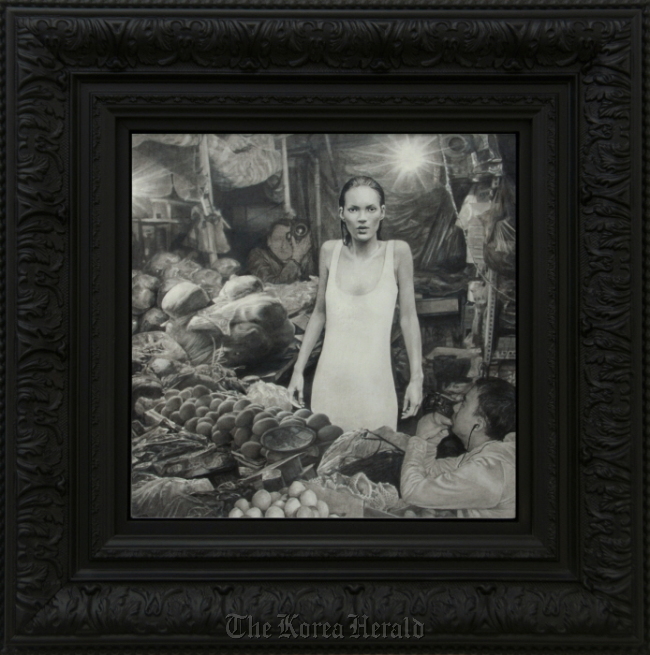New generation finds own ways to channel social messagesAn exhibition is putting young Chinese artists under the spotlight this month, offering insight into today’s Chinese art and society.
The exhibition held at Hakgojae Gallery in Seoul hosts eight contemporary artworks by emerging Chinese young artists ― Lu Zhengyuan, Ma Quisha, Ye Linghan, Zang Kunkun, Tu Hongtao, Pan Jian, Hao Liang and Huang Jingyuan ― all in their late 20s to 30s.
“The exhibition shows the current state of Chinese contemporary art and society,” the exhibition curator Yoon Jae-gap, who put together a group exhibition of Chinese artists 10 years ago to celebrate the 10th anniversary of diplomatic relations between South Korea and China.
The current exhibition is not related to this year’s 20th anniversary of diplomatic relations between two countries.
“Some say the artists born in the 1970s and 1980s seem weak, not serious and only look playful, but they have their own strategies to express their ideas and thoughts,” Yoon added.
The new generation of the Chinese art scene is emerging with the Chinese art world developing quickly through burgeoning art galleries and art auction market that set record prices frequently, driven by affluent art collectors.
This year, China accounted for 41.4 percent of global auction revenue, making it the top art market, beating the traditional U.S. and U.K players, according to Artprice.com, an art information website.
Each artist at the Hakgojae exhibition showcases his or her own signature style that shows the strategies for conveying social messages, quite contrary to the criticisms often levelled against them that they are not as outspoken as the previous generation of artists.
Huang Jingyuan, based in Beijing and educated in the U.S. and Canada, expresses criticism toward society with a touch of femininity.
In her painting series “Gossip from Confucius City,” Huang explores the issues of authority and materialism, manipulating photo images from the news and Internet.

“Gossip from Confucius City 8” by Huang Jingyuan. (Hakgojae Gallery)
“I gave the title because the Confucius Institute is a place where China promotes its traditional ideology and propaganda of Chinese culture ― quite government oriented,” Huang told The Korea Herald, adding the Chinese title is a little different because she didn’t want to make it too obvious in Chinese.
One of the series features two men, who look like top government authorities wearing sashes given as an award and a skinny model curled up inside a bubble in the front.
“The juxtaposition makes it really uncomfortable to see how these two guys look natural, but almost look like they are selling her, like an animal or display,” Huang said.
“The bubble girl is from a high fashion magazine photo and these two gentlemen’s faces are actually a combination of three different faces so it doesn’t represent an individual,” Huang said.
Huang explained young Chinese artists and activists find and adopt ways of expressing their ideas without getting in trouble with the authorities because they are already raised in a society embedded with the dilemma of being critical and expressive amid restrictions.
Twenty-six-year-old artist Zang Kunkun presented a large painting featuring fitness equipment installed in almost all residential areas by the Chinese government.
Zang made a huge equipment figure, a combination of different kinds of fitness equipments that looks useless, as a way to show that the equipment is not something for citizens’ quality of life but to control their behavior and psychologically castrate them.
Award-wining artist Hao Liang, 29, revives old Chinese traditional painting skills, long neglected since the Cultural Revolution period, incorporating them into his anatomical paintings.
The only video work by 30-year-old artist Ma Quisha is a narrative about herself as a single child raised during the one-child policy period and the major historical events that happened while she grew up, including the massacre in Tiananmen Square in 1989.
To better depict the turbulent events ― turbulent both on the personal level and society as a whole ― she talks with a sharp razor in her mouth.
“I wanted to let viewers see and feel the psychological pain I and the Chinese society experienced throughout the turbulent years by seeing the actual physical pain from my having to speak with a razor in my mouth,” said Ma.
The exhibition “Cynical Resistance” continues through July 25 at Hakgojae Gallery in Samcheong-dong, Seoul. For more information, call (02) 720-1524.
By Lee Woo-young (
wylee@heraldcorp.com)






